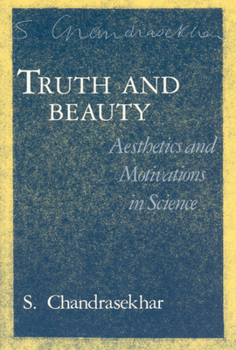Truth and Beauty: Aesthetics and Motivations in Science
Select Format
Select Condition 
Book Overview
"What a splendid book Reading it is a joy, and for me, at least, continuing reading it became compulsive. . . . Chandrasekhar is a distinguished astrophysicist and every one of the lectures bears the hallmark of all his work: precision, thoroughness, lucidity."-Sir Hermann Bondi, Nature The late S. Chandrasekhar was best known for his discovery of the upper
limit to the mass of a white dwarf star, for which he received the Nobel
Prize in Physics in 1983. He was the author of many books, including
The Mathematical Theory of Black Holes and, most recently,
Newton's Principia for the Common Reader.
limit to the mass of a white dwarf star, for which he received the Nobel
Prize in Physics in 1983. He was the author of many books, including
The Mathematical Theory of Black Holes and, most recently,
Newton's Principia for the Common Reader.
Format:Paperback
Language:English
ISBN:0226100871
ISBN13:9780226100876
Release Date:October 1990
Publisher:University of Chicago Press
Length:180 Pages
Weight:0.60 lbs.
Dimensions:0.5" x 6.1" x 9.1"
Customer Reviews
2 ratings
Excellent facts by a master!
Published by Thriftbooks.com User , 15 years ago
Professor Chandrasekhar was not only a brilliant physicist, but he was also a very caring and wonderful human being. His views on the aesthetics and motivations in science clearly show his love of fellow beings and how to inspire the younger generation.
Dreams and essays are made of these
Published by Thriftbooks.com User , 27 years ago
Let me admit at the outset that I read the collection of lectures quite some time back. However, I remember with amazing clarity how much the lectures moved me. Chandrasekhar is not a man who draws superficial parallels between artstic endeavour and the scientific process. What the essays reveal are something incredibly personal. They reflect what one of the most prominent Astrophysicists of our time feel about aesthetics - from the perspective of C.P Snow's "Two cultures". And Art, seen from this scientist's point of view, seems to be all the richer for it, contrary to popular belief that rationality strips Art of its elemental passion. The essays go to show that the world we think we live in is not so fragmented after all, and keen perception, augmented with a desire to express, can smoothen the shards that have been left behind in the wake of reductionist thinking. If you have ever dreamed about the creative cogwheels in scientific history, the essays go to show that they the burning need for an aesthetic whole need not be fundamentally different in the Arts. But there is a interesting and debatable point - which is linked with the unproductive geriatric scientist, and his equally productive counterpart. But for the last chapter, based on the Karl Schwarzchild lectures on general relativity, most of the essays are at the "scientifically educated" level. One of the most remarkable chapters is about Arthur Eddington, and the Chandrasekhar's open-mindedness is assesing the acutely "conservative" giant of Stellar Physics for his contributions and his drawbacks. One cannot be overwhelmed by history at such moments. What M.C. Escher's offered the world of mathematical paradoxies and oddities with his lithographs is somewhat symbiotic to Chandrasekhar's lectures. One can only hope that these subtle threads between the "two cultures" will remain.





